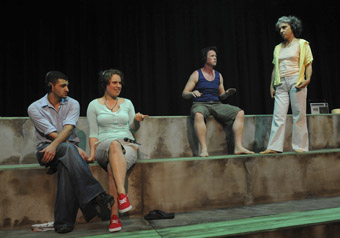learning to listen
caroline wake: utp’s stories of love & hate

Mohammed Ahmad, Janie Gibson, Roderic Byrnes, Katia Molino, Stories of Love & Hate, Urban Theatre Projects
photo Heidrun Löhr
Mohammed Ahmad, Janie Gibson, Roderic Byrnes, Katia Molino, Stories of Love & Hate, Urban Theatre Projects
IT IS A DUBIOUS GENRE TO HAVE WITHIN THE NATIONAL REPERTOIRE BUT THERE ARE NOW SEVERAL PLAYS WRITTEN IN RESPONSE THE CRONULLA RIOTS IN 2005. THESE INCLUDE SUZIE MILLER’S ALL THE BLOOD AND ALL THE WATER, NOELLE JANACZEWSKA’S AND ATYP’S THIS TERRITORY, LAURA SCRIVANO’S THE CRONULLA PROJECT, AND BIGHART’S JUNK THEORY. AMONG THE MOST RECENT AND MOST ACCOMPLISHED OF THESE IS URBAN THEATRE PROJECTS’ STORIES OF LOVE & HATE.
Rather than confronting the Cronulla riots directly, director Roslyn Oades comes at the issue from an angle, stating in her program note that the play “is not a work about the riots, but rather a work about the ordinary people who were there.” As with her previous effort, Fast Cars & Tractor Engines (RT 70, p41), Oades has interviewed dozens of people in order create an audio-script, which is then played through headphones to actors, who repeat the lines as they hear them.
The first voice we hear is Oades’, piped in over the loudspeaker. She is in the process of setting up an interview with a young man and asking him for a definition of love. He offers one before endearingly asking “Is that alright? Do you agree?” We also meet a middle-aged couple, whose love is such that he still buys her flowers: “the other day,” he says; “the other month”, she says simultaneously. For others, love is less about a person and more about an activity such as surfing—“It’s like being in the fallopian tube again, I reckon”, “It’s a whole-body out-of-body experience”—or driving. One of the young men finds the sound of the bass literally heart-stopping—“It’s true!” he exclaims, “You can die from bass!” From here we segue into Love Song Dedications and as the strains of Kenny G’s saxophone waft through the space, Richard Mercer takes a call. These love song dedications scenes recur throughout the production to lessening effect—they seem a touch contrived and too easy to parody. Nevertheless, they provide sound artist Bob Scott with the opportunity to air a few old favourites including “Sexual Healing”, “Under the Bridge”, “O What a Beautiful Morning!” and “I Wouldn’t Trade You For the World.”
Having circled around the topic of love, the play slowly spirals inwards towards issues of hate and eventually to the events themselves. Intriguingly, divisions emerge within as well as between communities. One character is careful to point out that Punchbowl is no Mount Druitt and three young Lebanese men jokingly refer to their “ghetto” and debate whether or not they are Lebanese, wogs, Middle Eastern Australians or Middle Eastern wogs. Likewise, surfies are dismissive of those who have Southern Cross tattoos that mean nothing whereas they have scars that tell “ridiculous stories.” When the discussion finally moves to the day of the riot, the surfers insist that there were hardly any locals at the scene, that it was mainly “roo shooters and Romper Stompers.” Whoever was there was intent on violence, as a policeman and photographer reveal. A flower-giving husband is revealed as the baton-wielding policeman who saved two men who were being beaten on the train. So shocked is the photographer by the ferocity of these attacks, he says simply, “I put my camera down. I put my camera down.”
Playing against type, gender, and ethnicity, the actors do not always manage to bridge the gap between performer and character. However this does not make the work any less interesting for the spectator. On the contrary, it is fascinating to listen to Roderic Byrnes imitate the intonations of a proud Lebanese father, to hear Mohammed Ahmad giggling as a schoolgirl, to see Katia Molino’s uncanny incarnation of a conceited Cronulla schoolgirl, and to watch Janie Gibson adopting the language and posture of a young Lebanese man.
In the final scene, we hear the recording of an old lady as well as Molino’s repetition of it. Inevitably they are not the same and this serves not only as a metatheatrical reminder about the nature of repetition and mediation, but also makes visible the invisible labour of listening. Listening is a strain, it demands intense concentration, and despite our best efforts we sometimes mis-hear and repeat something else as in Chinese Whispers. The mention of this game hints at the hidden connections between multiculturalism and verbatim theatre. So much of the rhetoric surrounding both is about enabling subaltern or minority subjects to speak to the mainstream. But through its distinctive performance mode Stories of Love & Hate succeeds in shifting the emphasis from speaking to listening. In doing so the work shifts the language of multiculturalism itself, returning responsibility to mainstream subjects and asking ‘How do you listen?’ To whom and in what context? And when was the last time you really listened?’
The arduous listening of Oades and her cast contrasts sharply with the profound absence of listening that lies at the heart of the Cronulla riots. In repeating these stories of love and hate with such sensitivity and artistry, the performance provides us with an opportunity to re-hear our fellow citizens and to rehearse new modes of local, cultural, and national belonging.
Urban Theatre Projects, Stories of Love & Hate, direction & original concept Roslyn Oades, performer Mohammed Ahmad, Roderic Byrnes, Janie Gibson, Katia Molino, designer Clare Britton, sound artist Bob Scott, lighting designer Neil Simpson; Hazelhurst Regional Art Gallery, Gymea, November 19-22; Olympic Parade Theatre, Bankstown, November 26-29, 2008
RealTime issue #89 Feb-March 2009 pg. 36






